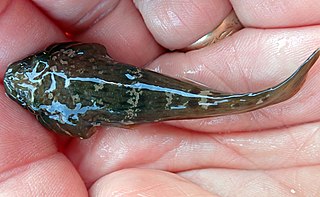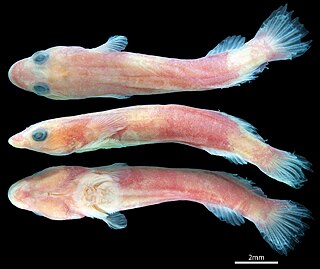The New Zealand urchin clingfish is a clingfish. It is found around New Zealand wherever sea urchins are present. Its length is between 2 and 3 cm.
Hector's clingfish, Gastroscyphus hectoris, is a clingfish of the family Gobiesocidae, the only species in the genus Gastrocyathus. It is found all down the east coast of New Zealand around the low water mark amongst seaweed, on rocky coastlines. Its length is up to 6.4 centimetres (2.5 in) SL. This species was described in 1876 by Albert Günther as Crepidogaster hectoris from a holotype collected on the south shore of the Cook Strait. Günther honoured the Scottish-born scientist James Hector (1834-1907) who was the Director of the Geological Survey of New Zealand and who presented type to the British Museum.
The giant clingfish, Haplocylix littoreus, is a clingfish of the family Gobiesocidae, the only species in the genus Haplocylix. It is found all down the east coast of New Zealand around the low water mark amongst seaweed, on rocky coastlines. Its length is up to 15 centimetres (5.9 in). This species was originally described as Cyclopterus littoreus in 1801 by Johann Reinhold Forster, John C. Briggs subsequently placed it in the monotypic genus Haplocylix. Its closest relative appears to be the Caribbean deepwater clingfish Gymnoscyphus ascitus.
Modicus tangaroa is a clingfish of the family Gobiesocidae, found only around New Zealand where it occurs on coarse substrates consisting of shell fragments and bryozoa at depths of 20–149 metres (66–489 ft). This species was described by Grahma S Hardy in 1983 from types collected from the research vessel Tangoroa over the Ranfurly Bank, East Cape in New Zealand, the species was named after the vessel.
Aspasmodes briggsi is a species of clingfish native to the Seychelles. This species grows to a length of 2.5 centimetres (0.98 in) SL. This species is the only known member of its genus. This species was described by J.L.B. Smith in 1957 from a type collected at La Digue, Seychelles. The specific name honours the author of a 1955 monograph on the clingfishes, the American ichthyologist John "Jack" C. Briggs (1920-2018) of the University of Florida.
Briggsia hastingsi is a species of clingfish so far only known from Rahah Bay, Oman. This species grows to a length of 2.2 centimetres (0.87 in) SL. This species is the only known member of its genus. It was described in 2009 from the only known specimen by Matthew T. Craig and John E. Randall. The generic name honours the clingfish systematicist John Carmon Briggs (1920-2018) of the Georgia Museum of Natural History while the specific name honours Philip A. Hastings of the Scripps Institute of Oceanography, who was the PhD supervisor of Matthew T. Craig and who sparked his interest in clingfishes.

The blunt-snouted clingfish is a species of clingfish found along the western Mediterranean Sea coasts from Spain to Italy. This species grows to a length of 5 centimetres (2.0 in) TL. The blunt-nosed clingfish is a little known species of shallow water along the littoral of the northern Mediterranean from Alicante to Sicily. Its range was formerly thought to extend to Israel and Syria in the east; however this was actually several closely related cryptic species. It can survive out of the water and occurs only among intertidal pebbles and sand.
Mendeleev's clingfish is a species of fish in the family Gobiesocidae endemic to Madang Province in Papua New Guinea. This species is the only known member of its genus. This species was described in 2005 by Artem Mikhailovich Prokofiev, the type being collected near the village of Bongu in Madang Province from the research vessel Dmitrii Mendeleev, referred to in its specific name. The vessel was in turn named in hours of the Russian chemist Dmitrii Mendeleev (1834-1907), the creator of the most widely recognised periodic table.
Pherallodiscus is a genus of clingfishes native to the central eastern Pacific Ocean along the coast of Mexico. Based on genetic studies the genus should be merged into Gobiesox.

The Posidonia clingfish is a species of clingfish native to the Australia coast. This species grows to a length of 2 centimetres (0.79 in) SL. Pale green to pale blue with fine spots forming dark reticulations on back and sides, larger blue spots often on back, and a pinkish to brown line from snout to gill cover. The posidonia clingfish is endemic to southern Australia where its range extends from Corner Inlet in Victoria west as far as Rottnest Island in Western Australia. It occurs down to a depth of 10 metres (33 ft) where it is found on macroalgae and within seagrass beds, its favoured substrate to adhere to is the leaves of the sea grass Posidonia australis. This species is the only known member of its genus and was described by John C. Briggs in 1993 with a type locality of Fiddler's Bay which is 16 kilometres south of Tamby Bay in South Australia. Briggs gave the species the specific name hutchinsi in honour of the ichthyologist Barry Hutchins of the Western Australia Museum in Perth, Western Australia.
Propherallodus briggsi is a species of clingfish native to the coasts of Japan. This species grows to a length of 3 centimetres (1.2 in) SL. This species is the only known member of its genus, it was described by Masaru Shiogaki and Yoshie Dotsu in 1983 with a type locality of Meshima Island, Japan. Its specific name honours the American ichthyologist John "Jack" C. Briggs (1920–2018).

Trachelochismus is a genus of clingfishes endemic to the shores of New Zealand, with currently three recognized species:
The São Tomé clingfish is a species of marine fish of the family Gobiesocidae (clingfish). It grows to 1.4 cm maximal length. It occurs in the eastern Atlantic Ocean, around the islands of São Tomé and Príncipe between 0 and 3 metres depth. The species was first described in 2007 by Ronald Fricke, its specific name honouring the collector of the type, marine biologist Peter Wirtz of Madeira.

Diplecogaster bimaculata, the two-spotted clingfish, is a species of fish in the family Gobiesocidae found in Black Sea, Mediterranean Sea and Atlantic Ocean where it is found on rocks and among seagrass or shell beds.
The dwarf shore eel is a species of clingfish from the family Gobiesocidae.It is a small species which attains a maximum total length of 4.5 centimetres (1.8 in). This species is transparent and its internal organs are clearly visible through its skin. It occurs at depths of 0 to 5 metres within beds of seagrass and sometimes in nearby reefs. It is endemic to southern Australia where its range extends from near Sydney in New South Wales to Houtman Abrolhos in Western Australia, including the northern and eastern coasta of Tasmania. This species was described by Victor G. Springer and Thomas H. Fraser in 1976 and the specific name honours the ichthyologist Douglass F. Hoese of the Australian Museum who provided Springer and Fraser with much of the material they used in their description.
Diplecogaster tonstricula, the Eastern Atlantic cleaner clingfish, is a species of clingfish from the family Gobiesocidae which is found in the tropical eastern North Atlantic Ocean. It has been observed cleaning larger species of fish.

Flexor is a genus of clingfish from the family Gobiesocidae. It is a monotypic genus, the sole member of which Flexor incus was described in 2018 by Kevin W. Conway, Andrew L. Stewart and Adam P. Summers from type specimens collected on Raoul Island and L’Esperance Rock in the Kermadec Islands. An unknown species of clingfish was known to occur in the Kermadecs and it had been provisionally assigned to the genus Aspasmogaster but when examined the specimens proved to belong to a new genus which they name Flexor in reference to the flexibility of clingfishes and incus which means "anvil", a reference to the anvil like shape of the type locality, Raoul Island.

Lepadichthys frenatus, the bridled clingfish, is a species of clingfish from the family Gobiesocidae. It is found on shallow reefs in the western Pacific Ocean.
Opeatogenys gracilis is a species of clingfish from the family Gobiesocidae which is found in the Mediterranean Sea and in the eastern Atlantic Ocean. Suggested common names for this species are the pygmy clingfish and the seagrass clingfish.
Opeatogenys cadenati is a species of clingfish from the family Gobiesocidae. It occurs in the eastern Atlantic and has been recorded off Ghana, Senegal and Morocco, as well as off the Canary Islands. This species was described by John C. Briggs in 1957 with a type locality of Chenal de Joal off Senegal. Briggs honoured the French ichthyologist Jean Cadenat (1908-1992) who was Director of the Marine Biological Section of the Institut Français d’Afrique Noire in Gorée, Senegal.





